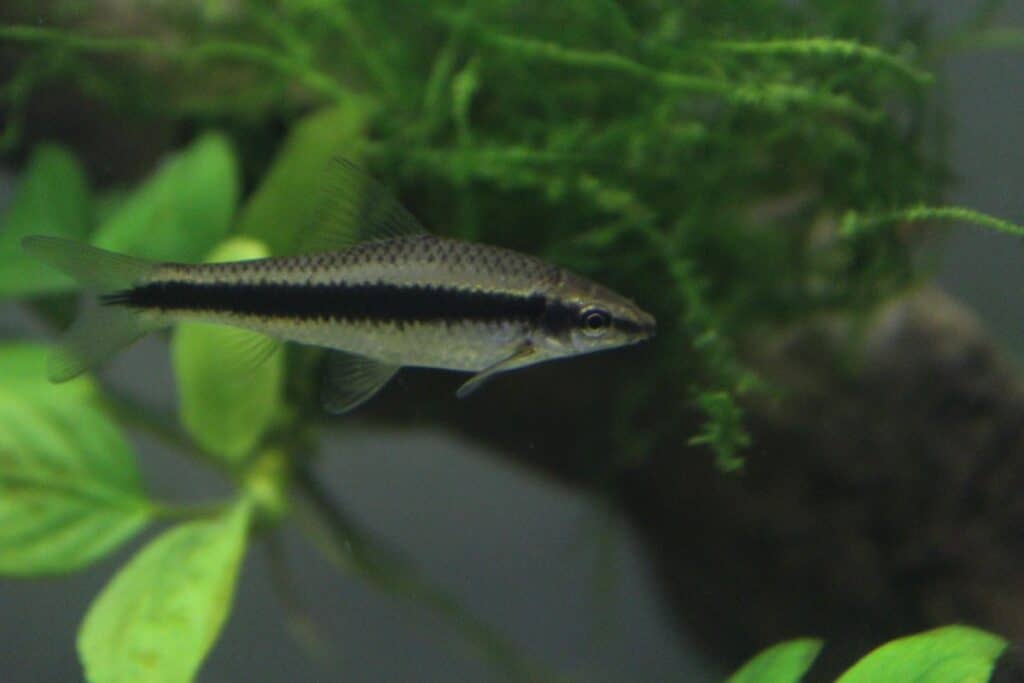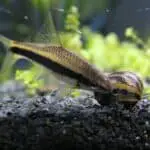Don’t you just hate when algae start taking over your aquarium?
The presence of algae is a good thing for your aquarium’s ecosystem, but algae overgrowth is unsightly and can be a nuisance. Too much of that green gunky stuff interferes with your fish’s health and destroys your tank’s appearance. The best solution? Getting an algae eater!
And one excellent fish that thrive on a diet of algae is the Siamese Algae Eater (Crossocheilus oblongus). This goldfish can eradicate excess algae and is the only aquarium species that feast on black algae.
The other great thing about the Siamese Algae Eater is that it is a relatively peaceful fish that can do well in groups. It is perfect for beginners who want to add different types of fish to a community aquarium.
If you want to learn more about this fish, keep reading!

Species Summary
The Siamese Algae Eaters are known under the Taxa Epalzeorhynchus siamensis and Crossocheilus siamensis. They’re native to Thailand; hence the epithet siamensis, passing through Burma (Myanmar), Cambodia, Laos, Singapore, and Malaysia and extending to Indonesia. The species is widely distributed from the Malay Peninsula to Java, Sumatra, and Borneo.
In the wild, they’re always away from large rivers and are in mountain streams or near rapids, clear waters, fast-flowing waters, and small lotic systems.
In captivity, they spend most of their time in the lower levels of the aquarium. They’re drawn to a spot covered in algae and stay there until everything disappears. Then, when kept in a small group, they swim together and eat in the same places.
Siamese Algae Eater Care Guide
The role of the Siamese Algae Eater is to take care of your algae problems, and it is likewise your job to take care of this fish and keep it thriving.
Tank Size
These medium to large-sized species are very active, so the aquarium should be a minimum of 17 gallons for a single fish and an additional 8 gallons for each you want to add. Keep a tight lid, as Siamese Algae Eaters are excellent jumpers.
Tank Mates
Thanks to its peaceful behavior, the Siamese Algae Eater can live with other fish in a community aquarium. However, as they love to stay at the bottom of the aquarium, you need to think carefully when adding other species that also inhabit the same region.
Many background dwellers can be territorial or intimidate those who get in their way. The Labeo Bicolor is a good example; they harass others to protect their territories. Then there are other fish that you can place without any problems. Corydoras and plecos are some of the most popular.
Fish living in other aquarium areas will not compete for territory with the Siamese Algae Eater. But remember: avoid more aggressive fish, which can attack and even eat the algae eater. This algae eater can act aggressively towards their species and chase other fish under stress.
Small and peaceful cichlids like the Angelfish and Discus, Barbs, Tetras, Danios, and Guppies do well with the Siamese Algae Eater.
Same Species Tanks
It only inhabits areas close to the substrate and decoration, so do not keep it only among its conspecifics.
Water Parameters
Keep the water temperature below 78 degrees Fahrenheit, ideally around 75, with an intense flow of water circulation and good oxygenation.
As it is a highly resistant fish, which inhabits different ranges of parameters, the other physicochemical characteristics of the water are of little importance: pH from 5.5 to 8.5 (easily tolerates brackish water), with total hardness GH from 1 to 8.5 30.
Take note that this fish is easily sensitive to nitrogenous compounds dispersed in water. As well as directly affecting the Siamese Algae Eater’s well-being, these compounds prevent the good formation of bacterial biofilm on hardscape or plant leaves.
What to Put in Their Tank
As the Siamese Algae Eaters are always at the bottom of the aquarium, a sandy substrate prevents them from scratching or hurting their barbels. You can add soft-leaved plants to serve as shelter and keep the water clean and oxygenated. Soft-leaved plants can be used. Also, create caves around the aquarium so they can have someplace to hide.
There is a slight chance that the Siamese Algae Eater will start nibbling on some of the plants if they cannot find other food. Therefore, keep them well-fed.
Common Diseases
Siamese Algae Eaters are not predisposed to diseases; they are robust and resistant fish. But in poorly managed aquariums, with constant destabilization of parameters, this fish can be affected by infections such as Ich.
Food and Diet
They are considered microphages; in their natural environment, they feed on periphyton and phytoplankton, with a preference for biofilm in the decoration elements. In addition, they are not that fussy in aquariums and will eat almost anything, including flake or pellet feed, algae crackers, and live foods.
You should avoid providing protein-rich foods as they cannot metabolize efficiently. Regular and prolonged consumption of high-protein foods can result in excessive fat deposits and even organ degeneration. Similarly, be careful not to overfeed the Siamese Algae Eater. Overfeeding can result in this fish ditching the algae and only feeding on what you give them.
The fact that adult Siamese Algae Eaters eat seaweed is a legend derived from their behavior of rummaging through the decor. But they don’t ingest algae (several studies on their stomachs have shown the virtual absence of plants). Instead, the adult fish hinders the growth of algae due to its activity on various surfaces.
Juveniles, on the other hand, are omnivorous, eating primarily algae at an early age (preferably green algae and rope algae, but not brown algae or diatoms).
Lifespan
Like other cyprinids, Siamese Algae Eaters live for quite a while, usually over ten years when well-kept.
Appearance
Siamese algae eaters are slender fish with a streamlined appearance.
They have a color ranging from light gray to slightly golden beige and display a black stripe that runs the entire body length, from nose to tail.
Around the mouth, they have a pair of small wattles. They have large eyes, and the tip of their head resembles a slightly upturned nose.
Their fins are transparent, with well-developed pectorals so they can support themselves on the substrate. Their tails are vital to swimming against the current and have a large, dorsal triangular shape.
Size
They are fish that acquire sizes considered significant, easily exceeding 6 inches in an aquarium.
In the wild, they grow and measure around 4 to 5 inches.
Behavior and Temperament
As illustrated, the Siamese Algae Eater is a peaceful fish. You can easily find it swimming in small schools, even with other species. But we recommend keeping a small shoal, so they are less shy and show their natural behavior.
Additionally, they spend most of their time at the bottom of the tank. When still young, these fish are pretty active, but this temperament changes with age and older fish spend more time on a particular decoration or plant.
These fish are very active during the day. They particularly appreciate large plants with broad-leaved species.
Even though they are very tolerant fish to other species, under stress and with dominance and fighting behavior, their longitudinal black bands running from the gills to the base of the tail turn silver. This is a sign that they feel uncomfortable in the aquarium.
Breeding
Being oviparous species, their natural reproduction in home aquariums is not documented, but large numbers are bred for the ornamental trade with the help of hormones.
It is suspected that these fish need streams with running water to reproduce, which is very difficult to simulate in domestic environments. Spawning can be triggered by changes in water conditions (temperature, pH, etc.), but currently, little is known about how to reproduce them.
Gender Differences: Male vs Female
Identifying the male and female can be difficult, as there are no visible differences between males and females until around 3-4 years of age.
Sexually mature females are noticeably more stocky than males.
Siamese Algae Eater Fun facts
● The natural habitat is in plains with streams that flow from the hills in fast rocky areas. Habitat degradation is a potential threat to this fish, especially in Java, Indonesia, where most major rivers are polluted.
● Crossocheilus; from Greek krossoi = fringe, border + Greek cheilos = lip, about the barbels on the upper lip in members of this genus. Langei, named after E. A. Lange, a health worker and hospital inspector in the Dutch East India Army, who sent the type specimen to Bleeker.
● It is believed to occur in Borneo, Peninsular Malaysia, southern and western Thailand, and possibly south Myanmar. The distribution of Crossocheilus spp., particularly in Thailand, requires further studies, as some populations may represent undescribed species.
● This species is among several similar congeners marketed as ‘Siamese algae eaters’ (often abbreviated to ‘SAE’), ‘Siamese flying fox,’ and ‘Crossocheilus siamensis.’ The latter became synonymous with Crossocheilus oblongus.
References
Baird, I.G., V. Inthaphaisy, P. Kisouvannalath, B. Phylavanh and B. Mounsouphom, 1999. The fishes of southern Lao. Lao Community Fisheries and Dolphin Protection Project. Ministry of Agriculture and Forestry, Lao
Rainboth, W.J., 1996. Fishes of the Cambodian Mekong. FAO species identification field guide for fishery purposes. FAO, Rome.
Kottelat, M., 2001. Fishes of Laos. WHT Publications Ltd., Colombo 5, Sri Lanka.








